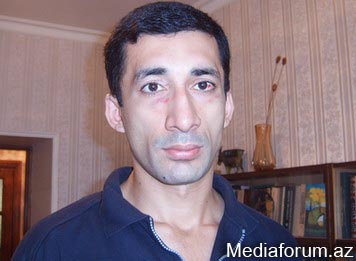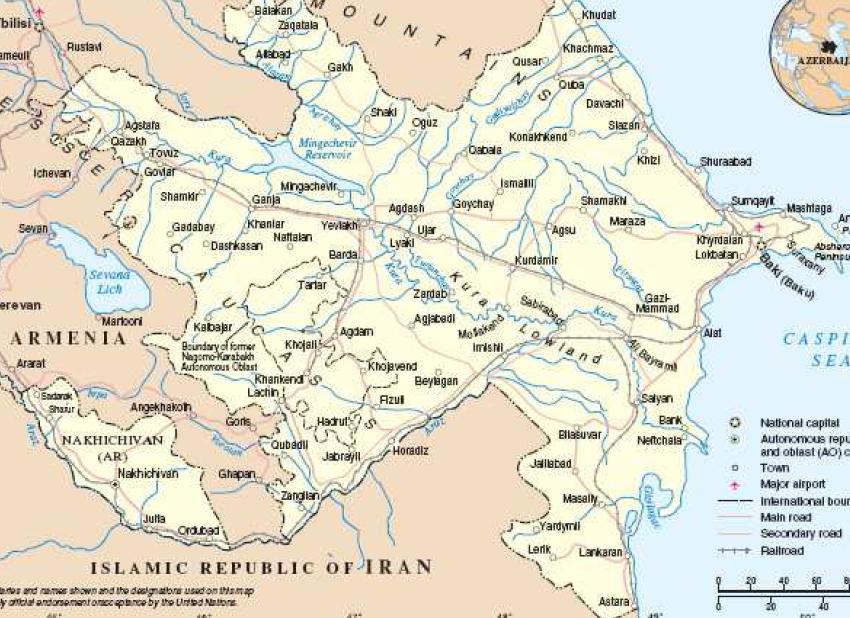Голос Талыша |
|---|
 Известные события, произошедшие с моей семьей за последние годы, всколыхнули нашу жизнь до основания.
|
|
Voice of Talysh
Всего материалов в каталоге: 49
Показано материалов: 41-49 |
Страницы: « 1 2 3 4 5 |
 36-aged
Emil Mamedov, the younger son of Professor Novruzali Mamedov, head of
the Talysh Culture Center and the Editor-in-chief of the Tolyshi Sado
(The Voice of Talysh) paper, who died in Prison 15 in Baku after long
persecution and mental pressure, suddenly died in Moscow this morning. 36-aged
Emil Mamedov, the younger son of Professor Novruzali Mamedov, head of
the Talysh Culture Center and the Editor-in-chief of the Tolyshi Sado
(The Voice of Talysh) paper, who died in Prison 15 in Baku after long
persecution and mental pressure, suddenly died in Moscow this morning.
"Evil destiny tracks this family,” the Chairman of the Committee for Novruzali Mamedov’s rights, Hilaal Mamedov said.
|
 Prof.
Hooshang Amirahmadi is the founder and president of
(www.american-iranian.org), holds a Ph.D. in planning and international
development from Cornell University and is a professor of the Edward
J.Bloustein School of Planning and Public Policy, at Rutgers University
Professor Amirahmadi has served as director of the University's Center
for Middle Eastern Studies, as chair and graduate director of his
department at the Bloustein School, and as the University Coordinator of
the Hubert Humphrey Fellowship Program. Dr. Amirahmadi is also a
founder of the Center for Iranian Research and Analysis and served as
its director for many years. He was a candidate for President in the
Ninth Presidential Election in Iran in June 2005, but the conservative
and religious Guardian Council disqualified him for his American
citizenship and democratic platform. Dr. Amirahmadi is also the
president of Caspian Associates, Inc.
(http://www.caspian-associates.com), an international strategic
consulting firm headquartered in Princeton, New Jersey. Prof.
Hooshang Amirahmadi is the founder and president of
(www.american-iranian.org), holds a Ph.D. in planning and international
development from Cornell University and is a professor of the Edward
J.Bloustein School of Planning and Public Policy, at Rutgers University
Professor Amirahmadi has served as director of the University's Center
for Middle Eastern Studies, as chair and graduate director of his
department at the Bloustein School, and as the University Coordinator of
the Hubert Humphrey Fellowship Program. Dr. Amirahmadi is also a
founder of the Center for Iranian Research and Analysis and served as
its director for many years. He was a candidate for President in the
Ninth Presidential Election in Iran in June 2005, but the conservative
and religious Guardian Council disqualified him for his American
citizenship and democratic platform. Dr. Amirahmadi is also the
president of Caspian Associates, Inc.
(http://www.caspian-associates.com), an international strategic
consulting firm headquartered in Princeton, New Jersey. |
 ABSTRACT ABSTRACT
This thesis looks at the identification of positive vernacular orientation in the
Talysh community of the city of Sumgayit, for the purpose of gaining a greater
understanding of its causes. Positive vernacular orientation is defined as exhibition
of a preferred status for the vernacular in sociolinguistic behaviour. Positive
vernacular orientation is described in three areas of sociolinguistic behaviour:
patterns of vernacular language use, vernacular language proficiency and frequency
of vernacular-speaking individuals in social networks. Data was collected through
personal interviews. The questionnaires for these interviews were developed using
a qualitative-relational research approach. The description of positive vernacular
orientation takes the form of a criteria-based typology of which an analysis of
influential factors is ultimately made. This analysis of influential factors
demonstrates the interaction between positive vernacular orientation as described in
the typology and the contextual elements of the family, socio-economic dynamics
and individual attitudes.
A total of 13 types of individuals demonstrating positive vernacular orientation
are identified. Variation in vernacular orientation is shown to pattern itself according
to differences in generation and time of arrival or birth in Sumgayit. |
 The
formation of Talysh ethnos penetrated different stages, and it has long
history. As one of the earliest foci of human civilization the territory
of Talysh people is rich of the archaeological monuments of ancient
period when people lived in the caves. Under the effects of different
factors the people concentrated in the mountains, gradually began to
realize their generality/community, which led to the formation of the
ethnic name Talysh/Tolish (Tolish is the self call of Talyshians).
Furthermore, in the territories inhabited by Talysh people there are
many place names, river names and mountain names [Talarud, TAROM (name
of the mountain)], which are close in the sounding to the ethno name
Talysh: the large part of the mountains of Iranian plateau, including
the Little Asia mountains in this or other way is connected with the
ethno name Talysh. The
formation of Talysh ethnos penetrated different stages, and it has long
history. As one of the earliest foci of human civilization the territory
of Talysh people is rich of the archaeological monuments of ancient
period when people lived in the caves. Under the effects of different
factors the people concentrated in the mountains, gradually began to
realize their generality/community, which led to the formation of the
ethnic name Talysh/Tolish (Tolish is the self call of Talyshians).
Furthermore, in the territories inhabited by Talysh people there are
many place names, river names and mountain names [Talarud, TAROM (name
of the mountain)], which are close in the sounding to the ethno name
Talysh: the large part of the mountains of Iranian plateau, including
the Little Asia mountains in this or other way is connected with the
ethno name Talysh.
There is much information proving the antiquity of the ethno name
Talysh. Iranian historian Sadik Isfagani considered that "Talysh was the
name of the son of Yafeta, son of Noy, from it is given the name to the
tribe in Gilan, and from the name of the tribe occurred the name of the
land; Talyshistan (Land of Talyshians). Arabs write this name as
Talysh. This information of Isfagani corresponds to the ideas of the
biblical authors, who counted the origin of Medes from Maday - the third
son of Yafesa. So basing on the information of the ancient authors it
is clearly possible to conclude that ethno name of Midyans (Medes) and
Talyshians raise to the united source - to Yafesu, the son of the
forefather of contemporary humanity Noy. |
 Abstract Abstract
This paper presents the results of sociolinguistic research conducted
between August 1999 and October 2000 among the Talysh people living in
southeastern Azerbaijan. The goals of the research were to investigate
patterns of language use, bilingualism, and language attitudes with
regard to the Talysh, Azerbaijani, and Russian languages in the Talysh
community. Of particular interest are the correlations between patterns
of language use and social isolation. Interviews, observations,
questionnaires, and an Azerbaijani Sentence Repetition Test were
employed.∗
1. Background
The Talysh language is a member of the northwest group of Iranian
languages. Historically, the language and its people are reported to
have roots in the Medes. Talysh is one of at least sixteen languages and
speech varieties in the Tati language group of northwestern Iran and
southern Azerbaijan. Talysh refer to themselves and their language as
‘Tolish’. The origin of the name ‘Tolish’ is not clear but is likely
quite old, predating the migration of the Iranian peoples to the
southwestern shores of the Caspian. |
 Novruzali Mammadov (Mart 10, 1942 -
August 17, 2009) was a Talysh national minority activist in Azerbaijan,
PhD in Philology, editor of the now-defunct newspaper "Talyshi Sado”
("Voice of the Talysh”), recognized as a political prisoner by
international organizations, being held in violation of his rights to
freedom of expression and association Mammadov also worked at the
Institute of Linguistics of the Azerbaijan National Academy of Sciences
and headed a Talysh cultural center, closed after his imprisonment. Novruzali Mammadov (Mart 10, 1942 -
August 17, 2009) was a Talysh national minority activist in Azerbaijan,
PhD in Philology, editor of the now-defunct newspaper "Talyshi Sado”
("Voice of the Talysh”), recognized as a political prisoner by
international organizations, being held in violation of his rights to
freedom of expression and association Mammadov also worked at the
Institute of Linguistics of the Azerbaijan National Academy of Sciences
and headed a Talysh cultural center, closed after his imprisonment.
On February 2, 2007, Mr. Novruzali Mammadov was called to the Ministry
of Internal Affairs, where he was kept for several days without
explanations, underwent beatings and was interrogated because he took
part in a scientific conference in Iran in 2004. After a short release,
he was detained at the Investigation Isolation Centre of the Ministry of
Internal Affairs, where he allegedly underwent physical and
psychological pressure for 15 days with the aim to force him to confess
the acts of "espionage” for Iran.
|
 1.1.4 Talysh 1.1.4 Talysh
The Talysh are an Iranian people who are settled in the south-eastern
part of Azerbaijan, mainly in the Lenkeran, Yardimly, Masalli, Lerik and
Astara districts. The 1999 census registered 76’800 Talyshs in
Azerbaijan. Primarily, they are rural residents (97 per cent). The
latest census however indicates their presence also in the cities of
Sumgayit and Baku. The 1999 census data undoubtedly under-represents the
actual number of the Talysh population. A more realistic number seems
to be between 200’000 and 250’000 Talysh living in Azerbaijan.
Some of the Soviet censuses ignored the existence of Talyshs in
Azerbaijan: the 1926 census counted 77’039 Talyshs living in Soviet
Azerbaijan (3.3 per cent). In the 1959, 1970 and 1979 censuses they
simply disappeared from the list of Soviet ethnicities. Only in the 1989
census the Talysh had again the possibility to indicate their
ethnicity. However, only 21’200 people registered as Talysh, which
corresponds to 0.3 per cent of the population of Soviet Azerbaijan.
|
 Interview with Dr.Hilal Mammadov,
Chairman of the Committee for protection of Novruzali Mammadov’s rights,
chief editor of the newspaper "Tolyshi Sado” ("Voice of Talysh”). Interview with Dr.Hilal Mammadov,
Chairman of the Committee for protection of Novruzali Mammadov’s rights,
chief editor of the newspaper "Tolyshi Sado” ("Voice of Talysh”).
(Published in the journal "Talysh”, Gilan province of Islamic Republic of Iran, October, 2009)
- Dr. Hilal Mammadov, the sudden death of Novruzali Mammadov in the
jail shocked and worried all the Talysh people living in Iran. Everybody
unanimously think that the death of the scientist is directly related
to his activity in the field of undertaking researches about Talysh
people. It’s obvious that he was not a politician; however he was
arrested and jailed without any proof of being guilty. I’d like to ask
you, as the chairman of the protection committee of the rights of N.
Mammadov; when and for what reason you think he died?
- Well, both in our country and many other countries around the world
agreed on the fact that he was arrested and then killed in the jail
purposely due to his activity related to protection of national and
cultural rights of Talysh people.
|
 Information on the condition of the Talyshi language.
Talyshi language being a member of the family of Irani languages belongs to the Indo-European language group. The specialists consider this language as a related language to the old Avesta language.
Historically, Talyshi language has been the native language of the people who live in the Talyshi region--south east of the Republic of Azerbaijan, the provinces of Gilan, Ardabil and others of Zenjan and Gazvin of the Islamic Republic of Iran.
According to unofficial information more than one million people in the Republic of Azerbaijan use Talyshi language at the level of every-day life.
|
|
|